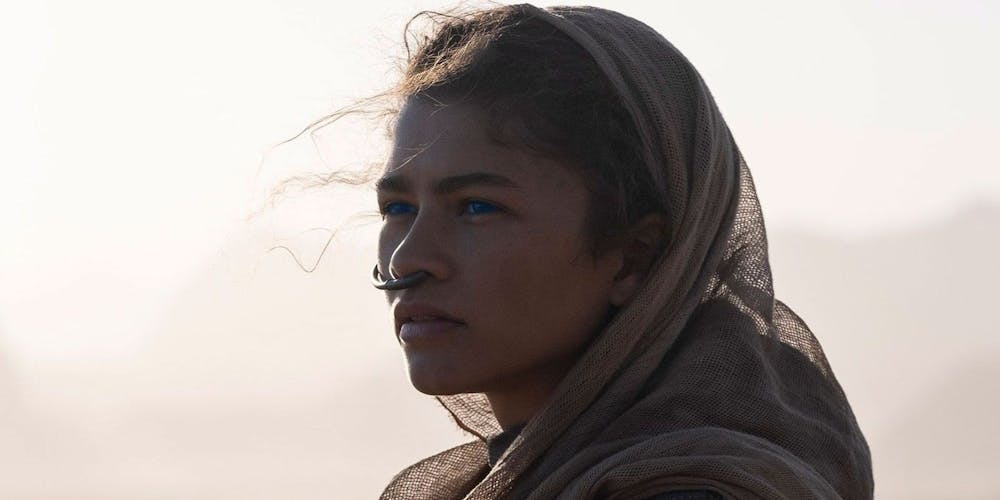Dune, the new sci-fi fantasy epic, released on Oct. 22, 2021, excited fans of the original novel and Zendaya fans alike around the world before its heavily anticipated release. However, the fans of Zendaya around the world would soon be disappointed to find that she barely made an on-screen appearance in the film. The false advertisement of her role sparked a much-needed conversation on Black Baiting in Hollywood.
Even before she clutched her first Emmy win, Zendaya was already becoming a household name. Her performance in Euphoria, one of HBO’s top new series in recent years, showcased her talent as a lead actress. She’s come a long way from being our beloved Rocky on Shake it Up in her Disney days. After her award-winning performance in Euphoria, many fans of Zendaya, myself included, were awaiting her blockbuster debut in film.
When the news of casting for Dune, a sci-fi adaptation of the 1965 novel written by Frank Herbert, got to the public there was mutual excitement of seeing Zendaya listed as Chani, the lead female role counterpart to Timothee Chalamet’s Paul Atreides. However, despite Chani being one of the main characters, her character is only in the movie for seven minutes.
With the runtime of the film being over two and a half hours, Zendaya’s character Chani is only in 4.5% of the film. The reaction throughout opening weekend was dominated by outrage from fans due to her lack of screen time. With Zendaya’s face being plastered on all of the promotional items for the film including the trailer and posters, her many interviews on the press tour and her own promotion of the film alongside Timothee Chalamet, everyone was expecting to see her amazing portrayal of Chani onscreen. The disappointment was palpable as you left the theater and was very evident online, as fans immediately started tweeting and commenting on the fact that she was only present in the last 30 minutes of the film.
It became evident that the use of Zendaya in the promotion of the film was just to get audiences in to buy tickets, shortly after it was announced that her character’s role is larger in the rest of the series, not the first book. The second Dune film had not yet been greenlit by Warner Brothers before the premiere, waiting to see how successful the film was. But the 300 million dollar box office earnings were due in part to Zendaya’s participation in the film, and her fans' very open wallets. This isn’t even the first time Zendaya has been used to market a film she is “featured” in. Marvel Studios Spiderman Homecoming gave us a Black MJ played by Zendaya, who is only a side character in the first film despite her being in almost every press interview before the film's release. She was also marketed as an acrobatic star in The Greatest Showman and yet again only had Zendaya in scenes with her romantic counterpart Zac Efron.
This baiting tactic is not new to movie marketing. Hollywood knows that the best way to get people to be excited about a film is through recognition. This means plastering posters all over billboards, ads, and social media but also using big-name actors who people recognize and want to see. Marketing teams budget thousands of dollars to make sure people spend money to see movies, especially on the opening weekend which is where studios project to make most of their earnings. P&A or Print and Advertising budgets can be up to half as much as the film cost to make and for a sci-fi epic like Dune with heavy costs for CGI, location and a star-studded cast earning money back is what determines success. Using names and faces people recognize is the most proven way to get exposure for films and earn money once the movie hits theaters and now streaming services as well. However, this tactic is extremely frustrating especially since this trend has expanded to using diversity to draw in audiences masquerading as representation.
Zendaya is a successful actress, a name that is recognized, she is also a prolific Black actress in Hollywood. Using her name and face means that an expanded audience of Black Americans will be reached. John Boyega fell victim to this as well with the Star Wars movie franchise. His role in the newest trilogy was manipulated in marketing to access a minority audience of Star Wars fans. This marketing tactic makes its profit from preying on an underrepresented demographic of moviegoers. Many fans echoed a sentiment of feeling “Zendaya Baited”, however, I would say that this trend exceeds just Zendaya and contributes to what I believe is Black Baiting as a whole. To use actors that will ensure black dollars go into a film’s revenue: this means advertising one or two black actors in a film and strategically placing them in ways to get exposure for the film to audiences that will pay to see them.
Even as more films are starting to have diverse casting, those roles are often smaller than they have been advertised. Hollywood now has realized that films that are more diverse make more money at the box office. However, to market a film to target marginalized communities is showcasing how minorities are continually being abused under capitalism from profitization. It is frustrating to fans of these actors and the communities they represent that they are being used to fatten white movie producers’ pockets. Within the industry itself, according to Adam B Vary, a Variety writer, 91% of studio heads are white and 82% are male. Though movie executives who oversee core studio operations that include marketing, casting, legal, etc. are approaching gender equity, with 59% being male, they are still 86% white.
There is more to creating diversity in a film than just adding more BIPOC actors into the casts. It also includes making sure that those roles are just as large as their faces on the promotional posters. There has been large success with putting large minority casts on screen such as Black Panther and Crazy Rich Asians. The key to diversity is not only seeing Black and brown faces but having their stories told as well. Our faces and our stories are worth more than just a ticket price.



